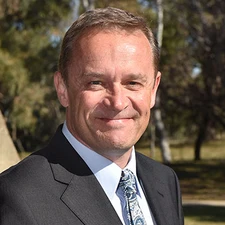Malcolm Sambridge

The 2021 Beno Gutenberg Medal is awarded to Malcolm Sambridge for his outstanding and creative contributions to the development, implementation, and selfless dissemination of stochastic inverse methods in seismology and the Earth science community at large.
Malcolm Sambridge is a seismologist and mathematical geophysicist working at Australian National University. He is a fellow of the American Geophysical Union, a fellow of the Australian Academy of Science, and the recipient of the Price Medal of London’s Royal Astronomical Society. As a graduate researcher at the Australian National University, Sambridge’s initial research focused on hypocenter location. His groundbreaking analysis introduced the concept of a “directed search”, an approach that has been adopted by the International Seismological Centre for their global earthquake catalog.
Sambridge’s creative, innovative, and highly interdisciplinary research often promotes radically new ideas. His work has led to significant progress in seismology, in particular in the improvement of tomographic images of Earth’s interior and the assessment of uncertainty in those images. His biggest contribution to seismology is the development of various Monte Carlo methods for the solution of nonlinear inference problems in the Earth sciences. Prominent examples include the Neighbourhood Algorithm, Genetic Algorithms, and transdimensional tomography. Though originally conceived in a seismological context, Sambridge’s developments in inversion techniques have enabled advances in climate science and sea level studies, crystallography and geologic dating, palaeontology, spectroscopy, tectonic plate reconstructions, and geomagnetism. He has started a whole new school of thinking about inverse problems. Sambridge’s 1999 classic on the Neighbourhood Algorithm alone led to a total of 1252 citations, an exceptional number by Earth science standards.
Among his generation, Sambridge is the “first name’‘ in geophysical inversion and sampling theory. This is attested by his considerable number of keynote-speaker invitations in the field of inverse problems. Sambridge has influenced a whole generation of Earth scientists not only through his science, but also through his willingness to share knowledge and to produce easily usable open-access software. It is therefore no surprise that his colleagues and students regularly describe him as the most unselfish scientist they know. This unselfishness is also reflected in Sambridge’s long-lasting efforts to promote seismology and to educate the younger generation not only by his teaching but also in much broader ways. The Seismometers in Schools initiative, led by him, has brought seismology into countless classrooms all over Australia using research-grade equipment.
